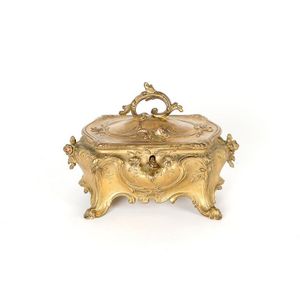Gilded Kapala Skull on Triangular Base with Vajra Finial
You must be a subscriber, and be logged in to view price and dealer details.
Subscribe Now to view actual auction price for this item
When you subscribe, you have the option of setting the currency in which to display prices to $Au, $US, $NZ or Stg.
- Finial - An architectural decoration, found on the upper parts of of an object. On furniture they are usually found on pediments, canopies and shelf supports. On smaller ceramic or silver items, such as spoons, they may decorate the top of the item itself, or the lid or cover where they provide a useful handle for removal.
Finials have a variety of shapes and forms. They may be urn-shaped, baluster shaped round or spiral, but usually taper into an upper point. Many real life shapes may also be used as finials, such as pineapples, berries, pinecones, buds, lotus and acorns. Sometimes animals such as a lion are depicted, or fish and dolphins. - Gilding - Gilding is a method of ornamentation whereby a thin sheet of gold metal is applied to items made of wood, leather, ceramics, glass and silver for decorative purposes.
For furniture including mirrors, the sheet of gold is usually applied over a coating of gesso. Gesso is a mixture of plaster of Paris and gypsum mixed with water and then applied to the carved wooden frames of mirrors and picture frames as a base for applying the gold leaf. After numerous coats of gesso have been applied, allowed to dry and then sanded a coat of "bole", a usually red coloured mixture of clay and glue is brushed on and allowed to dry, after which the gold leaf is applied. Over time parts of the gilding will rub off so the base colour can be seen. In water gilding, this was generally a blue colour, while in oil gilding, the under layer was often yellow. In Victorian times, gilders frequently used red as a pigment beneath the gold leaf.
Metal was often gilded by a process known as fire gilding. Gold mixed with mercury was applied and heated, causing the mercury to evaporate, the long-term effect of which was to kill or disable the craftsman or woman from mercury poisoning. The pursuit of beauty has claimed many victims, not the least of which were the artists who made those pieces so highly sought after today.
Visually similar items

An Art Nouveau gilt bronze jewel box, French, 19th century, 15 cm high, 20 cm wide, 13 cm deep

A substantial Japanese Satsuma vase and cover, Meiji period, C.1890, the main design of Buddhist arhats with side adornments of porcelain modelled ties in gilt gold and the base decorated with roundels, the lid decorated with a Shishi (Fo-dog) finial, this

A Nepalese/Tibetan gilt bronze Kapala (skullcup), 19th century, heavily cast, with five syllables on the cup, representing the five nectars being consumed or visualized by tantric practitioners. The base of the cup with five Sanskrit syllables in Rañjan sc

An eight armed Bodhisattva, the hair combed into a high Top-knot behind an ornate five-leaf diadem, the hair secured with a high topknot, adorned with beads and earrings, the curvaceous body seated upright with the robe falling in pleats around the upturne
